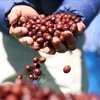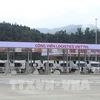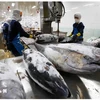Although Vietnam's humid tropical climate is perfect for banana farming, it has yet to capitalise and make great headway into the regional and global marketplace.
The country currently produces roughly 1.4 million tonnes of bananas per annum and its cultivation area makes up approximately 19% of the total fruit farming area nationwide, radio The Voice of Vietnam (VOV) reported.
However, banana plantation is not concentrated in any specific area and there is a definite lack of adequate transportation and preservation methods to assure that the fruit can timely find its way to the marketplace before turning rotten.
Le Si Cong, Director of La Ba Da Lat Company in Central Highland Lam Dong province, said that Japan could import around 10-20 tonnes of Laba banana a day, but Vietnam was not able to produce enough Laba banana to meet the demand.
In addition to Japan, the UK, Russia and Ukraine are also keen on Laba banana – a specialty fruit of the Central Highlands province of Lam Dong which once reserved for only the royalty and French living in Vietnam.
First introduced in the Laba-Phu Son area (now Duc Trong and Lam Ha districts) in the early 1920s, Laba banana was known for its special taste and flavour.
In the meantime, the cultivation area has been shrinking sharply and now only accounts for a mere 200ha in Lam Dong as farmers are shifting production to other fruits.
Vietnamese export value of bananas to China, Singapore, the Republic of Korea and many Eastern European countries has increased significantly for the past few months.
Export prices also rose by 20% correspondingly, but farmers simply do not have sufficient bananas to supply.
Currently, China needs to purchase around 20-30 tonnes per day, and Japan asks for 15-20 tonnes, yet Vietnamese bananas are in short supply.
In the near future, Vietnam needs to step up production and quality control standards to meet the regional markets’ demands.
Vietnam’s fruit and vegetables are now present in 40 markets around the world. Their export has risen steadily over the past few years, ranging from 628 million USD in 2011 to 829 million USD in 2012, before surpassing the billion dollar mark in 2013.-VNA
The country currently produces roughly 1.4 million tonnes of bananas per annum and its cultivation area makes up approximately 19% of the total fruit farming area nationwide, radio The Voice of Vietnam (VOV) reported.
However, banana plantation is not concentrated in any specific area and there is a definite lack of adequate transportation and preservation methods to assure that the fruit can timely find its way to the marketplace before turning rotten.
Le Si Cong, Director of La Ba Da Lat Company in Central Highland Lam Dong province, said that Japan could import around 10-20 tonnes of Laba banana a day, but Vietnam was not able to produce enough Laba banana to meet the demand.
In addition to Japan, the UK, Russia and Ukraine are also keen on Laba banana – a specialty fruit of the Central Highlands province of Lam Dong which once reserved for only the royalty and French living in Vietnam.
First introduced in the Laba-Phu Son area (now Duc Trong and Lam Ha districts) in the early 1920s, Laba banana was known for its special taste and flavour.
In the meantime, the cultivation area has been shrinking sharply and now only accounts for a mere 200ha in Lam Dong as farmers are shifting production to other fruits.
Vietnamese export value of bananas to China, Singapore, the Republic of Korea and many Eastern European countries has increased significantly for the past few months.
Export prices also rose by 20% correspondingly, but farmers simply do not have sufficient bananas to supply.
Currently, China needs to purchase around 20-30 tonnes per day, and Japan asks for 15-20 tonnes, yet Vietnamese bananas are in short supply.
In the near future, Vietnam needs to step up production and quality control standards to meet the regional markets’ demands.
Vietnam’s fruit and vegetables are now present in 40 markets around the world. Their export has risen steadily over the past few years, ranging from 628 million USD in 2011 to 829 million USD in 2012, before surpassing the billion dollar mark in 2013.-VNA



















